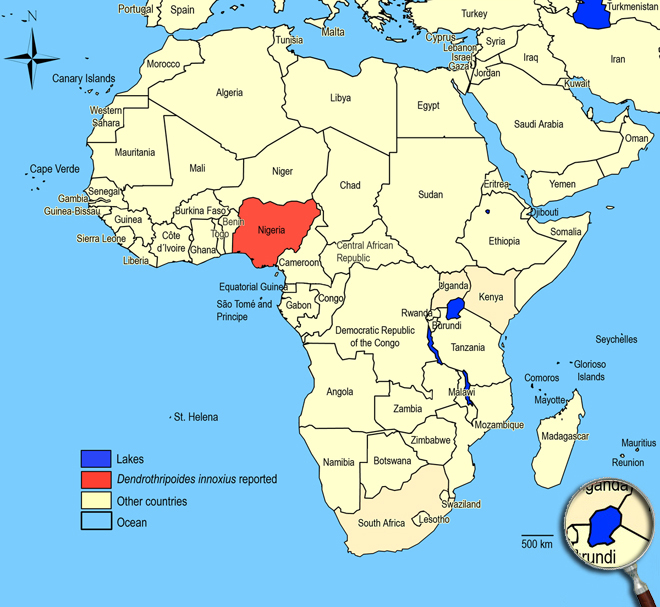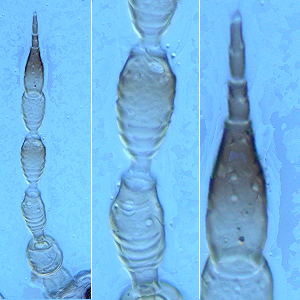Dendrothripoides innoxius (Karny, 1914)
Thripinae, Thripidae, Terebrantia, Thysanoptera
Figures
Fig. 1: 8-segmented antenna, segments III and IV with forked sense cone, terminal segments VI-VIII
Fig. 2: Head dorsal with ocellar triangle, scape and pedicel
Fig. 3: Head dorsal with ocellar triangle
Fig. 4: Pronotum
Fig. 5: Meso- and metanotum
Fig. 6: Fore wing and base of fore wing
Fig. 7: Tergites V-VII
Fig. 8: Tergites VIII-XI
Introduction and recognition
Dendrothripoides innoxius breeds on leaves of several species of Ipomoea, including cultivated sweet potato and Chinese water spinach. Female macropterous or micropterous (with wing lobe shorter than thorax width); body color golden yellow, with brown shadings laterally; antennal segments IV & VI brown in apical half or more, segments VII & VIII brown; fore wings pale with brown marking sub-basally and more extensively medially (about one-fourth to one-third in length). Antennae 8-segmented; segments III & IV with slender forked sense cone, VIII at most 1.5 times as long as VII (Fig. 1). Head with cheeks bulging behind eyes but constricted to basal neck; dorsal surface reticulate; with 2 pairs of ocellar setae, pair I absent, pair III on anterior margins of ocellar triangle (Fig. 2 and 3). Pronotum with discal setal bases prominent and without long setae; single posteroangular setae short and as long as discal setae (Fig. 4). Meso- and metafurca without spinula. Metanotum irregularly reticulate; median setae arise well behind anterior margin; campaniform sensilla present (Fig. 5). Mid and hind tarsi 2-segmented. Fore wing unusually slender; veinal setae minute (Fig. 6). Tergites II-VIII with numerous irregular arranged, stout and large microtrichia laterally; VI-VIII with 1 or 2 pairs of stout setae medially pointing toward midline (Fig. 7); IX & X with setae stout; X fully divided medially. Sternites without sculpture; median pair of setae on VII arising at margin (Fig. 8).
Male micropterous and similar to female; tergite IX with pair of stout thorn-like setae arising from a large median tubercle, posterior to this a group of 6 small tubercles; antecostal ridge of sternites IV-VII with small transverse glandular area.
Taxonomic identity
Species
Dendrothripoides innoxius (Karny, 1914)
Taxonomic history
Scirtothrips gladiiseta Girault, 1933
Heliothrips ipomeae Bondar, 1930
Tryphactothrips mundus Karny, 1927
Tryphactothrips mediosignatus Karny, 1925
Dendrothripoides ipomoeae Bagnall, 1923
Euthrips innoxius Karny, 1914
Common name
Sweet-potato thrips
Present taxonomic position
Family: Thripidae Stephens, 1829
Subfamily: Thripinae (Stephens) Karny, 1921
Genus: Dendrothripoides Bagnall, 1923
Genus description
The genus Dendrothripoides Bagnall, 1923
There are 5 known species included in this genus, one is from Southern Africa, three from Asia and the fifth, Dendrothripoides innoxius, is widespread around the world on Ipomoea leaves (Mound & Marullo 1996). The species in this genus have unique numerous stout tooth-like michrotrichia on the lateral thirds of the tergites, the fore wings are unusually slender, and the pronotum has a single pair of posteroangular setae.
Species description
Typical key character states of Dendrothripoides innoxius
Coloration and body sculpture
Body color: mainly pale to yellow, or with some darker markings
Surface of head, pronotum and fore legs: without obvious or with weakly reticulate sculpture
Antennae
Form of sense cones on antennal segments III and IV: emergent and forked on segments III and IV
Length of antennal segment III and IV: antennal segment III similar in length to segment IV
Forked sense cone on antennal segment IV: extending to a point at least a third to base of segment V
Number of antennal segments: 8
Antennal segment I: without any setae on dorsal apical margin
Antennal segment II: without an exceptionally long seta at the inner apex
Antennal segment II shape: symmetric
Antennal segment III shape: symmetric
Antennal segment IV and V: without a hyaline ring at the base
Antennal segment VI bears: not a remarkably dagger-shaped sensorium
Antennal segment VIII length: about 1.5 the length of antennal segment VII
Head
Distance between bases of ocellar setae III: greater than width of first ocellus
Head: not prolonged in front of compound eyes
Ocellar setae I: absent
Ocellar setae III: arising on anterior margin of, or in front of ocellar triangle
Ocelli: present
Length of postocular setae: not alternating short and long setae
Number of ocellar setae: 2
Prothorax
Number of pairs of long anteroangular setae: 0
Number of pairs of long posteroangular setae: 0 (1)
Number of pairs of elongate pronotal setae: 0 (1)
Pronotal blotch or internal apodeme: absent
Pronotum shape: broadly rectangular
Pronotum surface: with mainly equiangular reticulations
Pronotum posteroangular setae: short and as long as discal setae (never more than 0.5 times as long as the epimeral setae)
Pronotum posteromarginal/posteroangular setae: S2 longer than S3, not equal in length
Mesothorax
Mesosternal furca: without spinula
Metathorax
Metanotal campaniform sensilla: present
Metanotal median setae: S1 behind anterior margin
Metanotum with dominant sculptured triangle medially: absent
Metasternal furca: without spinula
Shape of metathoracic furca: transverse, V-shaped
Wings
Fore and hind wings: present, more than half as long as abdomen (macropterous) or not longer than thorax width (micropterous)
Fringe cilia arising: from sockets
Fore wing veins: present
Fore- and hind wing surface: covered with microtrichia
Apex of fore wing: with prominent terminal setae
Fore wing anterior margin (costal vein): with cilia but minute setae or without setae
Fore wing costal fringe cilia: arising at anterior margin of wing
Fore wing first vein: distinct from costal vein
Fore wing first vein setal row: incomplete, with setae not closely and uniformly spaced
Fore wing second vein setal row: incomplete, with setae not closely and uniformly spaced
Fore wing shape: mainly parallel sided or margins run continuously towards each other
Fore wing surface: not reticulate
Fringe cilia on posterior margin near apex: distinctly wavy (undulated)
Length of fore wing costal setae at middle of wing: minute or shorter than half of median wing width
Shape of fore wing apex: with mainly posterior margin curved to join anterior margin
Fore wing extreme apex color: pale
Fore wing median dark area: about one-fourth to one-third in length
Fore wings: alternating bands of dark and light
Legs
Fore tibia: not prolonged around fore tarsus
Mid and hind tarsi: with two segments
Color of fore tarsi: pale or yellow, sometimes apically shaded or brown
Abdomen
Pleurotergites: not covered in microtrichia
Sternite II: with marginal setae but no discal setae
Sternites IV, V and VI: with marginal setae but no discal setae
Sternite VII median posteromarginal setae S1: arising at posterior margin
Sternite VII: with marginal setae but no discal setae
Surface of lateral thirds of abdominal tergites: with many irregularly arranged, stout and large microtrichia
Tergites II to VII median setal pair: no more than 0.3 as long as median length of tergite
Tergites IV and V median setal pair: shorter than distance between their bases
Craspedum on tergites IV to VI: absent
Tergites V to VII: without ctenidia laterally, but sometimes with rows of microtrichia
Tergites VI and VII: with median pair of stout setae pointing toward midline
Craspedum on tergite VIII: without craspedum medially and toothlike microtrichia laterally
Tergite VIII ctenidia: without paired ctenidia laterally, sometimes with irregular microtrichia
Tergite VIII posteromarginal comb of microtrichia: absent
Tergite X: not tubular, longitudinally incomplete
Setae on abdominal tergite X: all setae slender

Similar or related species
Compared to Dendrothripoides venustus, Dendrothripoides innoxius has no elongate posteroangular pronotal setae (a single posteroangular seta is short and as long as discal setae), antennal segment VIII is at most 1.5 times as long as VII, fore wings are pale with brown markings sub-basally and more extensive medially (median dark band about one-fourth to one-third in length), and tergites VI & VII bear 1 or 2 pairs of stout setae medially pointing toward midline. Dendrothripoides venustus with 1 pair of elongate posteroangular pronotal setae which are twice the length of discal setae, antennal segment VIII is about twice as long as VII, the median dark area of fore wings are broad and about two-thirds in length, and tergites VI & VII bear a median pair of small and straight setae.
Species of Dendrothripoides are similar to species of Scirtothrips, Kenyattathrips katarinae, Neohydatothrips samayunkur and Hydatothrips adolfifriderici in having the surface of lateral thirds of tergites bearing numerous microtrichia, but only in the genus Dendrothripoides these microtrichia are irregular, stout and teeth-like. In other species the microtrichia are fine and normally arranged in regular rows.
Biology
Life history
As with other thrips species the life cycle from egg to adult is dependent on temperature. The full cycle can take less than one week to over a month and adults may live for more than one month producing several generations in one year depending on seasonal weather (Lewis 1973).
Host plants
Ipomoea (sweet potato, Ipomoea batalas, and chinese water spinach, Ipomoea aquatica).
Vector capacity
None identified, but possible mechanical distribution of phytopathogenic fungi and bacteria.
Damage and symptoms
-
Detection and control strategies
-
Additional notes
-
Biogeography
Oriental region, Pacific region, French Polynesia, India, Indonesia, Brazil, Panama, Carribean Islands, Australia. Nigeria.
African countries where Dendrothripoides innoxius has been reported

The species Dendrothripoides innoxius was not observed in surveys undertaken in East Africa on vegetables and associated weeds and crops.
Please click here for survey sites of all observed thrips species of Kenya, Tanzania and Uganda.

Bibliography
Bagnall RS (1923). Brief descriptions of new Thysanoptera - XIII. Annals and Magazine of Natural History, Zoology, Botany and Geology. (Serie 9) 12: 624-631
Girault AA (1933). Some beauties inhabitant not of commercial boudoirs but of nature's bosom, notably new insects. Published privately, Brisbane, 5 pp
Karny H (1914). Beiträge zur Kenntnis der Gallen von Java. Zweite Mitteilung über die javanischen Thysanopterocecidien und deren Bewohner. Zeitschrift für Wissenschaftliche Insektenbiologie. 10: 355-369
Karny H (1925). Die an Tabak auf Java und Sumatra angetroffenen Blasenfüsser. Bulletin van het deli Proefstation te Medan. 23: 1-55
Karny H (1926). Studies on Indian Thysanoptera. Memoirs of the Department of Agriculture in India, Entomological Series. 9 (6): 187-239
Kudo I (1977). The genus Dendrothripoides Bagnall (Thysanoptera, Thripidae). Japanese Journal of Entomology (Konchū). 45 (4): 495-500
Lewis T (1973). Thrips: their biology, ecology and economic importance. Academic Press Inc., London Ltd., 349 pp
Moritz G (2006). Thripse. Pflanzensaftsaugende Insekten, Bd. 1, (1. Auflage). Westarp, Hohenwarsleben, 384 pp. ISBN-13: 978 3 89432 891 7
Moritz G, Morris DC & Mound LA (2001). ThripsID - Pest thrips of the world. ACIAR and CSIRO Publishing Collingwood, Victoria, Australia, CDROM ISBN 1 86320 296 X
Moritz G, Mound LA, Morris DC & Goldarazena A (2004). Pest thrips of the world - an identification and information system using molecular and microscopical methods. Centre for Biological Information Technology, University of Queensland, Australia, CDROM ISBN 1 86499 781 8
Moritz G, O'Donnell C & Parrella M (2009). Pest thrips of North America. Centre for Biological Information Technology, University of Queensland, Australia, CDROM ISBN-13: 978 1 86499 940 2
Mound LA & Marullo R (1996). The Thrips of Central and South America: An introduction (Insecta: Thysanoptera). Memoirs on Entomology, International, Vol. 6. Associated Publishers, Gainesville, 487 pp
Nickle DA (2003). A checklist of commonly intercepted thrips (Thysanoptera) from Europe, the Mediterranean, and Africa at U.S. ports-of-entry (1983-1999). Part 1. Key to genera. Proceedings of the Entomological Society of Washington. 105 (1): 80-99
----
Web links
Mound´s Thysanoptera pages
Thysanoptera Checklist
ICIPE Thrips survey sites
UNI Halle & Thrips sites
Thrips of California











